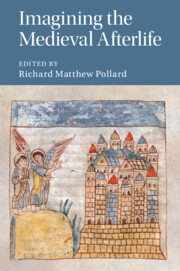15 results
Part IV - Notable Authors and Texts
-
- Book:
- Imagining the Medieval Afterlife
- Published online:
- 07 December 2020
- Print publication:
- 17 December 2020, pp 223-302
-
- Chapter
- Export citation
Contents
-
- Book:
- Imagining the Medieval Afterlife
- Published online:
- 07 December 2020
- Print publication:
- 17 December 2020, pp vii-viii
-
- Chapter
- Export citation
Part III - Artistic Impressions
-
- Book:
- Imagining the Medieval Afterlife
- Published online:
- 07 December 2020
- Print publication:
- 17 December 2020, pp 191-222
-
- Chapter
- Export citation
Contributors
-
- Book:
- Imagining the Medieval Afterlife
- Published online:
- 07 December 2020
- Print publication:
- 17 December 2020, pp xi-xii
-
- Chapter
- Export citation
Part I - Chronological Surveys
-
- Book:
- Imagining the Medieval Afterlife
- Published online:
- 07 December 2020
- Print publication:
- 17 December 2020, pp 7-130
-
- Chapter
- Export citation
Part II - Theological Perspectives
-
- Book:
- Imagining the Medieval Afterlife
- Published online:
- 07 December 2020
- Print publication:
- 17 December 2020, pp 131-190
-
- Chapter
- Export citation
Index
-
- Book:
- Imagining the Medieval Afterlife
- Published online:
- 07 December 2020
- Print publication:
- 17 December 2020, pp 343-352
-
- Chapter
- Export citation
Figures
-
- Book:
- Imagining the Medieval Afterlife
- Published online:
- 07 December 2020
- Print publication:
- 17 December 2020, pp ix-x
-
- Chapter
- Export citation
Bibliography
-
- Book:
- Imagining the Medieval Afterlife
- Published online:
- 07 December 2020
- Print publication:
- 17 December 2020, pp 303-342
-
- Chapter
- Export citation
Imagining the Medieval Afterlife: Introduction
-
-
- Book:
- Imagining the Medieval Afterlife
- Published online:
- 07 December 2020
- Print publication:
- 17 December 2020, pp 1-6
-
- Chapter
- Export citation
Preface and Acknowledgements
-
- Book:
- Imagining the Medieval Afterlife
- Published online:
- 07 December 2020
- Print publication:
- 17 December 2020, pp xiii-xiv
-
- Chapter
- Export citation
Abbreviations
-
- Book:
- Imagining the Medieval Afterlife
- Published online:
- 07 December 2020
- Print publication:
- 17 December 2020, pp xv-xviii
-
- Chapter
- Export citation
Copyright page
-
- Book:
- Imagining the Medieval Afterlife
- Published online:
- 07 December 2020
- Print publication:
- 17 December 2020, pp vi-vi
-
- Chapter
- Export citation

Imagining the Medieval Afterlife
-
- Published online:
- 07 December 2020
- Print publication:
- 17 December 2020
2 - Flavius Josephus: The Most Influential Classical Historian of the Early Middle Ages
- from Part I - Knowledge of the Past
-
-
- Book:
- Writing the Early Medieval West
- Published online:
- 25 May 2018
- Print publication:
- 03 May 2018, pp 15-32
-
- Chapter
- Export citation



